Accurate detection of typical absence seizures in adults and children using a two-channel electroencephalographic wearable behind the ears
- PMID: 34490891
- PMCID: PMC9292701
- DOI: 10.1111/epi.17061
Accurate detection of typical absence seizures in adults and children using a two-channel electroencephalographic wearable behind the ears
Abstract
Objective: Patients with absence epilepsy sensitivity <10% of their absences. The clinical gold standard to assess absence epilepsy is a 24-h electroencephalographic (EEG) recording, which is expensive, obtrusive, and time-consuming to review. We aimed to (1) investigate the performance of an unobtrusive, two-channel behind-the-ear EEG-based wearable, the Sensor Dot (SD), to detect typical absences in adults and children; and (2) develop a sensitive patient-specific absence seizure detection algorithm to reduce the review time of the recordings.
Methods: We recruited 12 patients (median age = 21 years, range = 8-50; seven female) who were admitted to the epilepsy monitoring units of University Hospitals Leuven for a 24-h 25-channel video-EEG recording to assess their refractory typical absences. Four additional behind-the-ear electrodes were attached for concomitant recording with the SD. Typical absences were defined as 3-Hz spike-and-wave discharges on EEG, lasting 3 s or longer. Seizures on SD were blindly annotated on the full recording and on the algorithm-labeled file and consequently compared to 25-channel EEG annotations. Patients or caregivers were asked to keep a seizure diary. Performance of the SD and seizure diary were measured using the F1 score.
Results: We concomitantly recorded 284 absences on video-EEG and SD. Our absence detection algorithm had a sensitivity of .983 and false positives per hour rate of .9138. Blind reading of full SD data resulted in sensitivity of .81, precision of .89, and F1 score of .73, whereas review of the algorithm-labeled files resulted in scores of .83, .89, and .87, respectively. Patient self-reporting gave sensitivity of .08, precision of 1.00, and F1 score of .15.
Significance: Using the wearable SD, epileptologists were able to reliably detect typical absence seizures. Our automated absence detection algorithm reduced the review time of a 24-h recording from 1-2 h to around 5-10 min.
Keywords: epilepsy; seizure detection algorithm; seizure underreporting; typical absence seizures; wearable seizure detection.
© 2021 The Authors. Epilepsia published by Wiley Periodicals LLC on behalf of International League Against Epilepsy.
Conflict of interest statement
L.L. has received speaker honoraria from and is participating on advisory boards for Zogenix, Livanova, UCB, Eisai, Novartis, NEL, and Epihunter. None of the other authors has any conflict of interest to disclose. We confirm that we have read the Journal’s position on issues involved in ethical publication and affirm that this report is consistent with those guidelines.
Figures




References
-
- Commission on Classification and Terminology of the International League Against Epilepsy . Proposal for revised clinical and electroencephalographic classification of epileptic seizures. Epilepsia. 1981;22(4):489–501. - PubMed
-
- Guilhoto LM. Absence epilepsy: continuum of clinical presentation and epigenetics? Seizure. 2017;44:53–7. - PubMed
Publication types
MeSH terms
LinkOut - more resources
Full Text Sources
Medical

